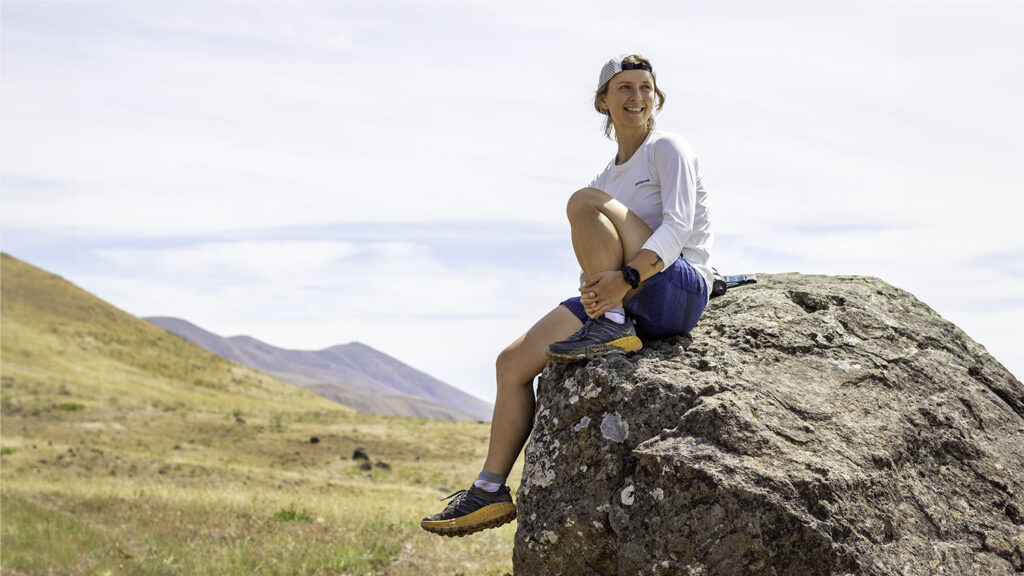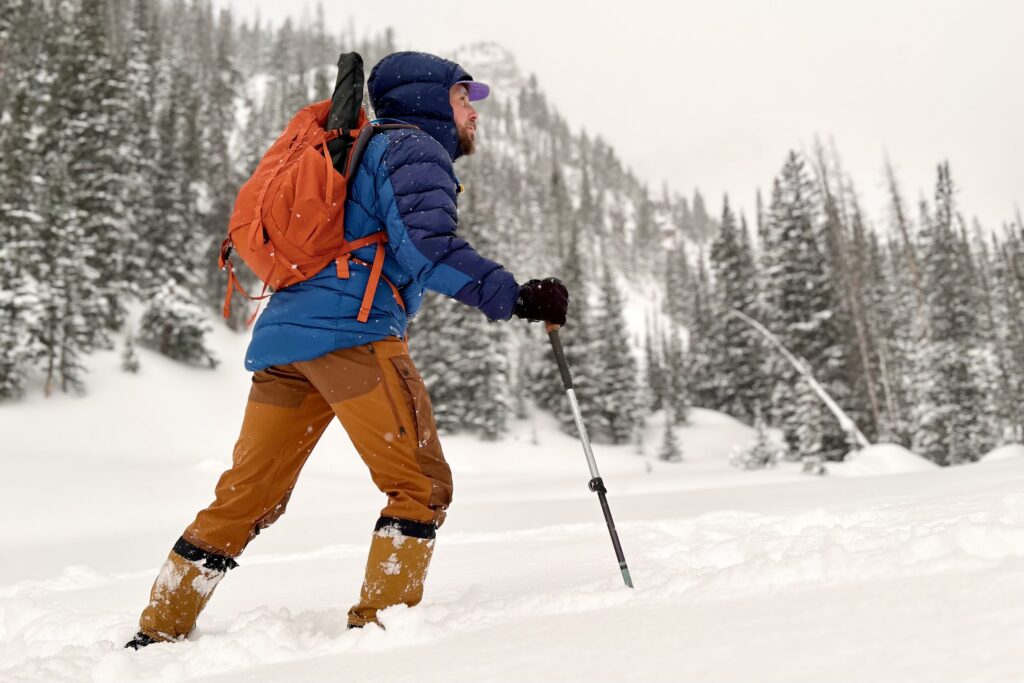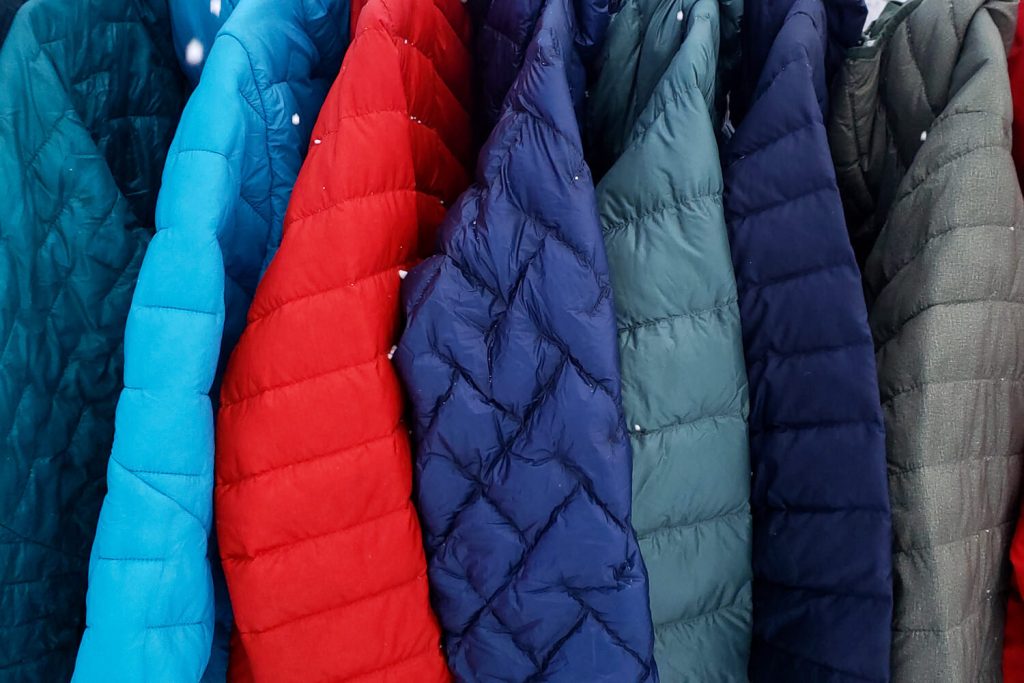
A good pair of hiking pants needs to be comfortable, and easy to move in, durable, breathable, weather resistant and have the right set of features—and it certainly doesn’t hurt if they have a stylish too.
From brands like Athleta, prAna, REI, Patagonia, Outdoor Research and more, our gear testers have hiked in over 40 pairs of hiking pants through rain, sun, and snow over thousands of miles to determine our favorites. Our expert advice in this guide will take the guesswork out of finding the best women’s hiking pants for you.
And for more info, check out some of our other popular gear guides:
Quick Picks For Women’s Hiking Pants
Check out this quick list of the best hiking pants for women if you’re in a hurry, or continue scrolling to see our full list of favorites with in-depth reviews.
Best Hiking Pants Overall: KUHL Freeflex Roll-Up ($99)
Best Convertible Hiking Pants: REI Sahara Convertible ($90)
Best Value: REI Trailmade ($70)
Best Jogger Pants: Athleta Trekkie North Jogger ($99)
Best Softshell Pants: Arc’teryx Gamma Pant ($200)
Best Everyday Activewear Pants: The North Face Aphrodite 2.0 ($80)
Lightweight, Stretchy & Breathable Hiking Pants: Outdoor Research Ferrosi ($99)
Best Ultralight Hiking Pants for Women: Mountain Hardwear Dynama/2 Ankle ($85)
Most Durable Leggings for Hiking: Fjallraven Abisko Trekking Tights HD ($175)
Exceptionally Comfortable Hiking Pants with a Flattering Fit: Patagonia Happy Hike Studio Pants ($99)
Durable Hiking Pants with a Classic Fit: prAna Halle Straight ($95)
What’s New
We’ve been hiking the extra miles to test new pairs of hiking pants to see how they stack up against our longtime favorites:
- The KUHL Freeflex Roll-up pants really impress us and earned the number one spot on our list. Plus, these are our favorite roll-up style pants.
- Athleta’s Trekkie North Jogger ranks highly with our testers and earns the title of best jogger for hiking.
- We added the softshell Arc’teryx Gamma Pants for their supreme durability and extreme weather-ready performance.
Women’s Hiking Pants Overall Testing Scores

KUHL Freeflex Roll-Up
Best Hiking Pants Overall
CleverHiker Rating: 84.3/100
Price: $99
Weight: 11.9 oz.
Fit: Relaxed
Fabric: Polyester
Pros
- Exceptionally durable
- Soft fabric is very comfortable
- Plethora of pockets
- Articulated knees make them easy to move in
- Highly breathable
- Stylish
- Inclusive sizing
Cons
- Not very weather-resistant
Looking for the best all-around hiking pants? Well, look no further! We’ve tested these pants everywhere from Arizona to Alaska and, after much consideration, have decided the Kuhl Freeflex Roll-Up offers the best combination of fashion and function.
A plethora of positive attributes stood out in these pants. For example, we like choosing from six functional pockets to store our electronics, maps, and snacks. These pants dry quickly when they get wet and are comfortable enough to wear for 12 + hours of hiking in the backcountry. Our favorite thing about them is how well they stand up to getting poked, raked, and whacked by plants while off-trail hiking. These pants are DURABLE, which means that one pair of pants will last a long time, making them well worth the purchase.
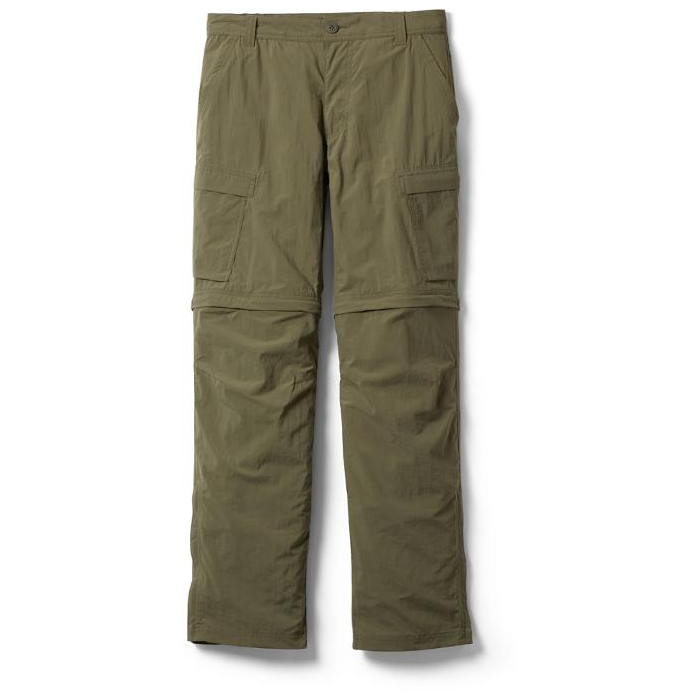
Women’s REI Sahara Convertible
Best Convertible Hiking Pants for Women
CleverHiker Rating: 76.3/100
Price: $90
Weight: 12.7 oz.
Inseam: 29
Fit: Relaxed
Fabric: 96% nylon, 4% Spandex
Pros
- Highly versatile
- Breathable
- Many useful pockets
- Easily converts to shorts
- Inclusive sizing
Cons
- Top & bottom can show uneven signs of wear
- Somewhat unflattering as pants & as shorts
REI’s beloved Sahara Convertible pants offer hikers the best of both worlds: full-length pants at one moment and shorts at the next. However, easily transitioning from one length to the next isn’t its only trick. We found that it offers abundant features and qualities that make it a solid choice for those looking to take their adventures to new heights.
While backpacking with these pants in the San Juan mountains, we found that they not only repel water well but also dry extremely quickly, a rare trick considering most pants only do one or the other well rather than both. We greatly appreciate that these pants have seen improved durability over the years and love having a variety of pockets that are actually large enough to use.

Women’s REI Trailmade
Best Budget Hiking Pants
CleverHiker Rating: 73/100
Price: $70
Weight: 8.1 oz.
Inseam: 29.25
Fit: Relaxed
Fabric: 94% nylon, 6% Spandex
Pros
- Affordable
- Stylish
- Articulated knees make them easy to move in
- Highly breathable
- Inclusive sizing
Cons
- Trades some durability for low weight
The REI Trailmade hiking pants offer an affordable option for “traditional” hiking pants. While wearing these pants on several backpacking trips in the San Juan mountains, we found them comfortable, had great pockets, and dried quickly. More specifically, they were one of our go-to hiking pants to wear all day because they weren’t restrictive or bulky but still had the features we needed to thrive on the trail.
The biggest downside we found was lower-quality durability. They can be prone to developing holes if poked or rubbed by a sharp object. That said, the reasonable price tag makes them our top choice for beginner backpackers who are just starting out or those on a strict budget.

Athleta Trekkie North High Rise Jogger
Best Jogger Pants
CleverHiker Rating: 66.8/100
Price: $99
Weight: 9.5 oz.
Inseam: 29.25
Fit: Straight
Fabric: 95% Nylon, 5% Spandex
Pros
- Exceptionally comfortable
- Stretchy fabric is easy to move in
- Stylish
- Better pockets than most joggers
- Inclusive sizing
Cons
- Takes a long time to dry
For a great mix of comfort, features, and durability within the jogger style, we like the Athleta Trekkie North Joggers. Compared to competing models, the Trekkies have bigger, better pockets that can fit a modern smartphone. The zippers are a great addition to keep things from falling out. We also found them to be much more durable than their jogger counterparts, with material that can withstand abrasions and snags.
These pants fall short in one important category: drying time. Our side-by-side testing revealed a very long dry time. Not only that, but they seem to soak up water rather than repel it. For those reasons, we cannot recommend these pants to anyone looking to use them in extremely wet environments or when you’ll be exposed to the elements for extended periods. However, the fact that they are so comfortable and durable means that they still have their uses, and we would gladly bring these pants with us on a trip to the desert.

Women’s Arc’teryx Gamma Pants
Best Softshell Pants
CleverHiker Rating: 65/100
Price: $200
Weight: 10.4 oz.
Inseam: 31
Fit: Fitted
Fabric: nylon/spandex weave
Pros
- Extremely durable
- Easy to use waist cinch
- Wind resistant
- DWR finish
- Made with recycled materials
Cons
- Extremely expensive
We love the Gamma pants for their incredible durability, streamlined features, and weather resistance. During testing, we brought these pants with us on a rugged backpacking trip in Arizona’s Blue Range Primitive Area. The Gamma pants were a lifesaver while hiking through dense growth of pokey plants in a burned drainage and did not show any signs of use afterwards. Other things we love about these pants include the easy-to-use waist cinch and water resistant qualities. To us, those things make these pants well worth the big price tag. However, we recognize that most hikers do not hike in these types of conditions and thus the pants may not hold as much value.

Women’s The North Face Aphrodite 2.0
Best Everyday Hiking Pants
CleverHiker Rating: 64.5/100
Price: $80
Weight: 8.6 oz.
Fit: Straight-leg
Fabric: 95% nylon, 5% elastane
Pros
- Above-average comfort
- Less expensive
- Easy to adjust length with ankle cinch
- Stretchy fabric is easy to move in
- Lightweight
- Inclusive sizing
Cons
- Minimal pockets
- Not as durable
The North Face Aphrodite 2.0 pants are a great compromise between more traditional, heavy-duty pants and lightweight joggers. They are comfortable to wear, have decent pockets, and have okay durability. While testing these pants, we found that the softer material and looser fit made them about as comfortable to wear as a pair of sweatpants. We frequently wear them at home and on the trail because they are so comfy.
The Aphrodite pants have features that fall somewhere between more technical pants and lighter-weight models. The pockets are more usable than most joggers we have tried, but there aren’t as many of them as some of the more traditional hiking pants. The durability was generally better than lighter-weight pants, though the problem with piling and loose threads meant they wouldn’t be our first choice for off-trail excursions.

Women’s Outdoor Research Ferrosi
Lightweight, Stretchy & Breathable Hiking Pants
CleverHiker Rating: 63/100
Price: $99
Weight: 9 oz.
Inseam: 30.5
Fit: Straight-leg
Fabric: 86% ripstop nylon, 14% Spandex
Pros
- Exceptionally comfortable
- Articulated knees & stretchy fabric easy to move in
- Highly breathable
- More weather-resistant than many others
- Lightweight
- Length is adjustable with ankle cinch
- Inclusive sizing
Cons
- A bit expensive
- Ankle cinch isn’t very durable
The Outdoor Research Ferrosi pants are a well-rounded pair of hiking pants that shed inclement weather better than most. These pants are made with a stretchy spandex and ripstop nylon blend that’s wind, abrasion, and water-resistant making them feel more like wearing a soft shell than a typical hiking pant.
The stretchy fabric allows you to easily tackle rock scrambles and fallen trees on the trail without impeding your movement, so the Ferrosi pants are great for challenging hikes. The fabric is also highly breathable, but if you start to get a little warm while hoofing it uphill – you can use the cinches at the ankle to convert these pants into capris to catch a breeze.
While we love the drawcords at the ankle for adjusting the height, they’re not as secure or durable as the snaps found on many other roll-up pants. One of the ankle cinches actually broke during our first test hike with our first pair of Ferrosis. Our second testing pair has fared much better, but we’ve learned to treat the cinch with care to avoid mishaps.
That said, there are plenty of other small details to love. The thoughtful pocket layout provides plenty of storage options without feeling busy – one back pocket and the thigh pocket even have low-profile zippers for keeping small items secure. The side of the waistband that sits against your skin is extra soft, and there are multiple ways to dial in the right fit at the waist including a button closure, a drawstring, and belt loops.
Overall we really like the Ferrosi pants, and recommend them for hikers looking for a lightweight option that’s more technical than others in their weight class. Though they’re a bit more expensive, they’re worth the cost for hikers embarking on multi-day adventures where weather can be unpredictable.
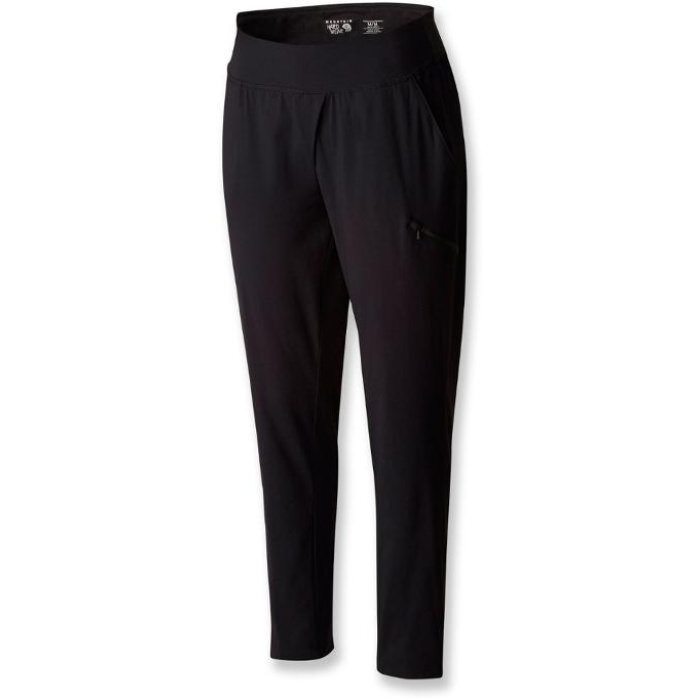
Women’s Mountain Hardwear Dynama/2 Ankle
Best Ultralight Hiking Pants
CleverHiker Rating: 62/100
Price: $85
Weight: 6.6 oz.
Inseam: 30
Fit: Tapered, ankle cut
Fabric: 94% nylon, 6% elastane
Pros
- Exceptionally comfortable
- Less expensive
- Stylish
- Ultralight
- Breathable
- Stretchy fabric is easy to move in
- Inclusive sizing
Cons
- Ankle height isn’t as protective as full-length pants
- Minimal pockets
- Waistband stretches over time
For comfort and style that extends beyond the trail, we love the Mountain Hardwear Dynama/2 Ankle Pants. Mentally and physically, we feel great wearing these pants. They are well cut, a bit loose, and have lovely, light fabric. During our tests, we found that while these pants are not all that water-resistant, they dry quickly. Unfortunately, while wearing these on some of our backpacking trips, we discovered that the pockets are pretty much useless on these pants, which was a big downside for us. We also wish they had belt loops or a waist tie to keep them from falling down when the elastic stretches out. Durability wasn’t the Dynama’s biggest strength either, but that may be a fair trade-off for those looking for a light pair of pants. Overall, it’s all about understanding what niche a pair of pants fill, and this pair of activewear is best for town-to-trail joggers.

Women’s Fjallraven Abisko Trekking Tights HD
Most Durable Leggings for Hiking
CleverHiker Rating: 60.5/100
Price: $175
Weight: 8.6 oz.
Inseam: 32
Fabric: 71% polyester, 29% elastane, Cordura in reinforced areas
Pros
- Exceptionally durable
- Stretchy fabric is easy to move in
- Lightweight
- Very comfortable
- Useful pockets
Cons
- Expensive
- Ankle height isn’t as protective as full-length pants
- A bit warm for hot summer conditions
The Fjallraven Abisko Trekking Tights HD have a strange way of making you feel ready for anything when you put them on. The compression is supportive without being constricting, and the high elastane content makes technical maneuvers easy to accomplish.
These tights are expensive, so they’re best for those who are sure they’ll put them to hard use. The Abiskos are ready for serious mountain adventures and should last you for a very long time thanks to the reinforced Cordura panels on the seat and knees.
We often find that the pockets on leggings tend to be a little lackluster compared to those on hiking pants, but the Abiskos have great storage options – actually better than many women’s hiking pants. There are two deep, stretchy pockets – an open one on the left leg for easy access, and a pocket with a flap over the top on the right leg for securing items. Large smartphones will fit in the leg pockets without impeding movement, and the compression keeps items from looking or feeling bulky in the pockets.
The thick, durable fabric on the Abiskos can be a bit hot, so we tend to reserve these for spring and fall hikes or treks at high altitude where we won’t have to worry about overheating. That said, the fabric wicks moisture well and a quick trail break every now and then will help keep you at a comfortable temperature in these leggings. One of our gear testers took the Abiskos on a fall backpacking trip through Washington’s Goat Rocks Wilderness, and she really appreciated the extra warmth while taking in the sights at the frozen alpine lakes.
While the Abiskos aren’t exactly pants, we felt they deserved a prominent spot on this list because they offer more durability than many of the lighter-weight hiking pants featured. If you’re a fan of leggings, you might also want to check out our full list of the Best Hiking Leggings.

Women’s Patagonia Happy Hike
Exceptionally Comfortable Hiking Pants with a Flattering Fit
CleverHiker Rating: 59.5/100
Price: $99
Weight: 9.4 oz.
Fit: Tapered, ankle cut
Fabric: 89% polyester, 11% Spandex
Pros
- Exceptionally comfortable
- Stretchy fabric is easy to move in
- Breathable
- Stylish
- Made in a Fair Trade Certified factory
Cons
- A bit expensive
- Ankle height isn’t as protective as full-length pants
- No waist adjustments
- Pockets aren't as practical
The Patagonia Happy Hikes are some of the comfiest hiking pants we’ve ever worn thanks to their breathable fabric, soft waistband, and four-way stretch. These pants feel like a performance jogger with their flattering ankle-length cut and roomy fit that follows curves without restricting movement.
The waistband on the Happy Hikes is wide to eliminate pinch points and flat to sit comfortably under a hipbelt. It doesn’t have a drawstring, but we find the stretchy fabric and tapered cut to be plenty secure enough without any sort of adjustment.
CleverHiker Senior Gear Analyst, Casey Handley, practically lives in the Happy Hikes during spring and fall because the ankle height provides an excellent balance of coverage and temperature regulation. She wore these pants for a particularly toasty hike on the Three Fingered Jack Loop and loved that the elastic ankle cuffs can be used to secure them at the calf – like capris – on really hot days.
We’re happy to see many outdoor companies moving toward more sustainable practices and ethical business models, but Patagonia takes it a step further. The Happy Hikes are made with over 90% recycled materials in a Fair Trade Certified factory which makes the slightly higher price more palatable. In order to ensure workers are treated fairly, things need to be priced fairly according to the quality of materials and labor.
We like the Happy Hikes so much that we often wear them around the house or for running errands when we want to look put together with minimal effort. Their flattering fit will keep you feeling cool and confident on the trail, and they transition seamlessly to post-hike drinks. The stylish, do-it-all Happy Hike pants are an ideal pick for casual hikers looking for a new favorite pair of pants to live in.

prAna Halle Straight Pant
Best Budget Hiking Pants
CleverHiker Rating: 54.5/100
Price: $95
Weight: 12.2 oz.
Fit: Straight Leg
Fabric: 97% Nylon, 3% Elastane
Pros
- Affordable
- Stylish
- Articulated knees make them easy to move in
- Highly breathable
- Inclusive sizing
Cons
- Trades some durability for low weight
The prAna Halle Straight pants have a classic, streamlined look and a design that balances performance and trail-to-town wearability. The fabric of the Halles is thicker than that of many other hiking pants on this list, so they’re some of the more durable pants we feature.
The Halles run a bit warm, but they still feel comfy and breathable enough for shoulder seasons. If you’ve been a longtime lover of the Halles, you’ll be pleased to know that the pockets on the newest iteration are deeper than those on the previous model – they can now accommodate most smartphones. Hikers who prioritize function over form will love the practical Halle pants. These built-tough bottoms are down for the most rugged adventures on your bucket list.
Product Comparison Table
| oSort | Product | Price | Weight | Inseam | Fit | Fabric | Comfort | Durability | Breathability | Features | Weather Resistance | 0 |
KUHL Freeflex Roll-Up View at REI View at KUHL |
$99 | 11.9 oz. | 26.5 | Relaxed | Polyester | 7.5 | 9.5 | 8 | 9.5 | 7 | 1 |
REI Sahara Convertible View at REI |
$90 | 12.7 oz. | 29 | Relaxed | 96% nylon, 4% Spandex | 5 | 8 | 9.5 | 9 | 9.5 | 2 |
REI Trailmade View at REI |
$70 | 8.1 oz. | 29.25 | Relaxed | 94% nylon, 6% Spandex | 8 | 5 | 9 | 8 | 8.5 | 3 |
Athleta Trekkie North High Rise Jogger View at Athleta |
$99 | 9.5 oz. | 29.25 | Straight | 95% Nylon, 5% Spandex | 9 | 7 | 3.5 | 6 | 4.5 | 4 |
The North Face Aphrodite 2.0 View at REI View at Amazon |
$80 | 8.6 oz. | 29 | Straight-leg | 95% nylon, 5% elastane | 8.5 | 5 | 5 | 7 | 6 | 5 |
Mountain Hardwear Dynama/2 Ankle View at Amazon View at REI |
$85 | 6.6 oz. | 30 | Tapered, ankle cut | 94% nylon, 6% elastane | 8.5 | 4 | 7 | 4 | 8 | 6 |
Arc’teryx Gamma Pants View at REI |
$200 | 10.4 oz. | 31 | Fitted | nylon/spandex weave | 5 | 8 | 5 | 6 | 9.5 | 7 |
Outdoor Research Ferrosi View at REI View at Amazon |
$99 | 9 oz. | 30.5 | Straight-leg | 86% ripstop nylon, 14% Spandex | 6 | 4 | 8 | 8 | 9 | 8 |
Fjallraven Abisko Trekking Tights HD View at REI View at Amazon |
$175 | 8.6 oz. | 32 | Next to skin, high waist | 71% polyester, 29% elastane, Cordura in reinforced areas | 8 | 5 | 6 | 5 | 5 | 9 |
Patagonia Happy Hike View at REI View at Patagonia |
$99 | 9.4 oz. | 32 | Tapered, ankle cut | 89% polyester, 11% Spandex | 8 | 4 | 7 | 4 | 7 | 10 |
prAna Halle Straight Pant View at prAna |
$95 | 12.2 oz. | 30 | Straight Leg | 97% Nylon, 3% Elastane | 5 | 6 | 5 | 4 | 8 |
|---|

How We Test & Methodology
We rigorously tested each pair of pants using a variety of metrics to determine which was the best. Our process looked at comfort and mobility, durability, breathability, features, and weather resistance. We spent several weeks using these pants on day hikes and backpacking trips around the San Juan mountains.
COMFORT & MOBILITY
One of our biggest pet peeves when wearing pants on the trail is the feeling of resistance on the legs while hiking uphill. The extra effort needed to lift the leg when the body is already at maximum exertion is literally a drag. For that reason, we tested each pair of pants for mobility by measuring how high we could lift each leg before feeling resistance from the pants. We started with the leg on the ground and lifted the leg until the pants seemed to pull against the leg. At this point, we stopped and then measured the distance from the edge of the knee to the ground. We repeated this process with the other leg and then averaged the distances. We used this data to compare the mobility of each pair of pants and assign initial rankings.
The second component of this metric is how comfortable each pair of pants is. We wore each pair of pants on at least one backpacking trip, where we had a fully loaded pack and hiked anywhere from five to 20 miles per day. We noted how the pants felt: were they tight or constricting in places? Were there any weird pressure points from zippers? How did the waistband feel with a pack on? How did the fabric feel on the skin both while sitting and walking? Did we feel like we looked good while wearing them? Which pants did we want to spend time wearing and why? After addressing those questions, we used the results to adjust the final rankings from our mobility results.
DURABILITY
The longevity of gear is an important consideration when choosing pieces that provide good value and are reliable on the trail. Along the same lines, a big reason we skip the shorts and go for pants is that they provide extra protection from pokey plants, snagging bushes, and sharp rocks. With those reasons in mind, durability was a key area of testing when evaluating the quality of each pair of pants.
To test for durability, we conducted individual and side-by-side reviews. Each pair of pants was taken out into the Colorado Rockies on various backpacking trips. These trips allowed us to see how the pants held up to a fully loaded pack on the hips, the potential wear on the ankle cuffs from mud and rocks, and just general regular use. We wanted to keep things fair as there was variety in the trail conditions on our hikes. To do so, we took each pair of pants and rubbed a section of the fabric on rough materials such as tree bark and a pokey branch to see how the fabric would react
BREATHABILITY
Rain, water crossings, dew, and sweat happen. When they do, wearing pants that quickly wick away the moisture is highly beneficial. To analyze this, we lined up all the pants we tested and dunked the bottom three inches in water to soak the fabric. Then, we timed how long it took the fabric to dry and gave each model a ranking. By performing this test side-by-side, we ensured that conditions like the amount of wind, sunshine, temperature, and humidity were the same for every pair of pants. We also considered other features that affect breathability, such as the ventilation qualities of the pants and how hot we felt while wearing them.
FEATURES
There are a variety of features that can be found in hiking pants. We focused primarily on usable pockets and considered secondary features such as whether or not pants had waist drawstrings, belt loops, ankle cinches, convertible pants, or leg zippers. When looking at pockets, we placed an iPhone 15 Pro in one pocket at a time, then jumped up and down three times in a row. If the phone stayed in the pocket, we counted it as usable. We repeated this process for each pocket and then tallied the total number of usable pockets for each pair of pants. Rankings were primarily based on the number of pockets, with secondary features also considered.
WEATHER RESISTANCE
The final metric we considered was how water-resistant each pair of pants was. To test this, we wore each pair of pants and then used a squirt bottle set on the mist setting to spray the pants from about a foot away. We counted the number of squirts needed for the water to stop beading on the outer layer and start soaking into the fabric. This number of squirts was used to rank the pants, along with our experience using these models in the field in wet conditions.

Why Trust CleverHiker?
Gear Analyst, Bailey Bremner, has covered some major backcountry ground. With over 600 nights and around 8,500 miles on trails across the U.S. with various pairs of pants, she knows hiking pants inside and out. She relied on pants to protect her legs while hiking rugged, off-trail routes such as the Western Wanderer Route, Columbine Route, and San Luis Loop, as well as classic thru-hikes, including the Colorado and Continental Divide Trails. While bushwhacking through the wilderness, she learned firsthand the importance of reliable gear and has made it her mission to become an expert on backpacking equipment.

Analysis & Results
We rank hiking pants based on six metrics: value, comfort & mobility, durability, breathability, features, and weather resistance. Our comparative results below outline the top performers in each metric.
VALUE
When deciding which pair of pants offered the best value, price and overall quality were the determining factors. Does a pair of pants provide a lot of bang for the buck? Most of the pants we tested had similar price tags, though a few outliers were more expensive. On the more affordable side, the REI Trailmade pants were the most affordable model we tested and also scored well across the board. Their many usable pockets and quick drying time make them well worth the purchase for beginner hikers on a budget. We also liked both the Khul FreeFlex Rollup and the REI Sahara Convertible pants because both pants are very reliable and offer high-quality options with a variety of features, breathability, and durability, all at a competitive price. Their durability means these pairs should last, saving you some green in the long run. Buyers looking for jogger-style pants may consider the Athleta Trekkie North Joggers for the best bang for the buck.
COMFORT & MOBILITY
Technical performance and features will only matter if the pants are comfortable to wear all day. We found a few standout favorites that were the least restrictive, felt effortless to move in, and generally the most pleasant to wear. Our overall most comfortable pair of pants was the Athleta Trekkie North Jogger. We like that they are loose around the knees but fit well around the hips and ankles, making it easier to hike up a steep hill and lounge around on the couch. They also work well for anyone who mountain bikes.
Other standouts include the Mountain Hardwear Dynama/2 Ankle and The North Face Aphrodite 2.0 pants. We found that the cut of the Dynama pants was flattering, which made us feel good and, thus, mentally comfortable wearing these pants. Like the Trekkies, they have the looser fit found in joggers, which makes it easier to move around. Less bulky features, like smaller zippers, make it more comfortable to lounge around in them. The main strength of Aphrodite pants is that they are made of very soft material. Wearing them feels like wearing a pair of scrubs or sweatpants.
DURABILITY
It doesn’t necessarily matter whether or not a pair of pants will be used for frequent bushwhacks or just for strolls close to home: durability impacts the overall longevity and versatility of a pair of pants. We were incredibly impressed with how sturdy the Khul FreeFlex Rollup pants were during testing. Even after we used these pants on a rugged, partially off-trail route in Alaska, they showed less wear and tear than some of the other pants we tested on milder trails near home. The REI Sahara and Arc’teryx Gamma pants also perform well. After using them in Colorado, the Sahara pants showed no signs of wear or tear. When we put these pants through our abrasion tests, they withstood well to rough surfaces and sharp objects. This is an impressive improvement from previous models that we have used. Being softshell pants, the Gamma pants are another great option for hikers facing off with some serious bush-whacking.
BREATHABILITY
Hiking pants are naturally warmer than wearing shorts, so reducing the amount of sweat in the rear is critical for staying comfortable on the trail. Features like roll-up snaps and extra ventilation can help, but quick-drying fabric is one of the best ways to reduce sweat and stay comfortable in moist environments. We had a few clear winners when we tested our lineup of hiking pants for their drying abilities and overall breathability. The top-performing pants for breathability ended up being the REI Sahara convertible pants. Not only did they dry the fastest, but they also were the easiest to ventilate because you can pull over and take the top-down on your convertible. While wearing them on one of our trips in the San Juan mountains, we were astounded by how quickly they dried after a fall rainstorm above treeline. Not too far behind, the REI Trailmade pants also wick moisture away like the wind, and the looser fit helps them feel cooler while on the trail. The Khul FreeFlex Rollup is another surprising option. They can be warmer due to the closer fit, but the fabric does a fantastic job of quickly wicking water and sweat away.
FEATURES
Pockets, drawstrings, ventilation, and other adjustable features galore are available in our top-ranked hiking pants for this category. We put a big emphasis on usable pockets; the idea of a phone falling out of a pocket while crossing a creek is not something we like to deal with. With that in mind, our stand-out performer is the Khul FreeFlex Rollup pants. One of our favorite things about these pants is the six pockets that are all large enough to fit a smartphone. Four pockets have envelope covers with snaps that are easy to use while walking to protect important gear pieces. The FreeFlex pants also sport a drawstring at the waist, belt loops, and snaps for rolling up the lower legs of the pants to convert them to capris.
The REI Sahara and Trailmade pants also stood out for their abundance of usable pockets and adjustability features. Both pants’ pockets were easily used in the field while hiking with a fully loaded pack.
WEATHER RESISTANCE
While the majority of hiking pants are not truly water-resistant and require the use of rain pants, there are a few that truly shed water. At the top of our list are the Arc’teryx Gamma pants, the only softshell pants on our list. They are also the only pants that are technically wind-resistant, thanks to a DWR finish. They perform well in the elements, making them an excellent choice for hiking year-round. We also like Outdoor Research Ferrosi and REI Sahara for their water-resistant qualities. During our testing, we were especially impressed with the REI Sahara as we could visibly see the water running down off of the pants during both a rain storm and our side-by-side testing.

How to Choose Hiking Pants
FABRIC
Many pants use a blend of fabrics to balance durability, weight, cost, and water resistance. Understanding the type of fabrics used can help you choose a pair of pants that fits a specific need.
Nylon
Nylon has several advantages as a garment fabric. It is slightly stretchier than polyester and does not absorb oils, meaning it will not smell after being washed. This fabric is known for being very durable overall and does not absorb much water. Any absorbed water stays cooler than other fabrics, which could be a pro in hot climates.
Polyester
Polyester is a truly hydrophobic fabric, meaning it does not absorb any water, though this depends slightly on the weave’s spacing. On the flip side, it readily holds onto oils, resulting in the fabric retaining body odor, even after going through the wash. This fabric does not stay as cold as Nylon when wet, making it a better choice for hikes in colder conditions.
Cotton
Cotton is widely used in everyday clothing thanks to how comfortable and sturdy it is for the price. Unfortunately, it is also extremely hydrophilic (attracts and retains water). This can be dangerous when hiking because once a cotton garment gets wet, it stays wet for a long time, exposing you to risks of hypothermia. It also may lead to bad cases of chafing due to repeated rubbing on the moist fabric. Therefore, wearing cotton-based fabrics while hiking is generally not a good idea.
Spandex/elastane
Spandex and elastane are often added to the fabric blends used to make pants as they help increase mobility. Nylon and polyester only provide so much give when lifting the leg or making dynamic movements. Adding a stretchier material makes lifting the leg easier, scrambling up a rock face, or getting up off the ground.

FIT / STYLE
Relaxed fit
Pants cut to have a relaxed fit are meant to be baggier and feel less restricting. The extra space often translates to a more comfortable user experience and better mobility as it is easier to move around.
Slim fit/ straight leg
Slim or straight-leg cuts tend to weigh less, thanks to the minimal material used to make the pants. The downside is that this provides less room for the leg to move, so being cognizant of other features that help with mobility is essential.
Articulated knees & gussets
Extra fabric, directional seams, and different materials at the knees are all strategies to improve mobility while wearing the pants. Pants without these features can feel restrictive in when you’re moving and grooving.
Integrated belts
Adding a drawstring at the waist can be critical for keeping a pair of pants from falling, particularly in models that do not include belt loops. We found that drawstrings made of stretchy material were more difficult to tighten appropriately and that thin material was less comfortable to wear.

CONVERTIBLES VS ROLLUPS
We tend not to use most of the pockets on hiking pants because items stored in them can feel bothersome and can impede movement. We generally prefer pants with fewer pockets because they look more sleek and feel more comfortable.
Convertibles
Pants that convert to shorts offer the pros of both worlds, but not always the highest quality of both. This pants style is not the most stylish to wear, and sometimes the connection point can feel uncomfortable on the leg. That said, these types of pants offer fantastic ventilation on very hot days and are easier to keep dry during deep water crossings. I can’t tell you how many people I’ve seen fall over while converting these pants, so just be sure to find a safe place to sit when you’re changing them over.
Rollups
In general, rollup-style pants are quicker to adjust and more comfortable than convertibles. Plus, they sport a trendy look. One thing to pay attention to is how high up the cuff’s built-in fabric straps are located: sometimes, the fabric may not be high enough for most creek crossings.
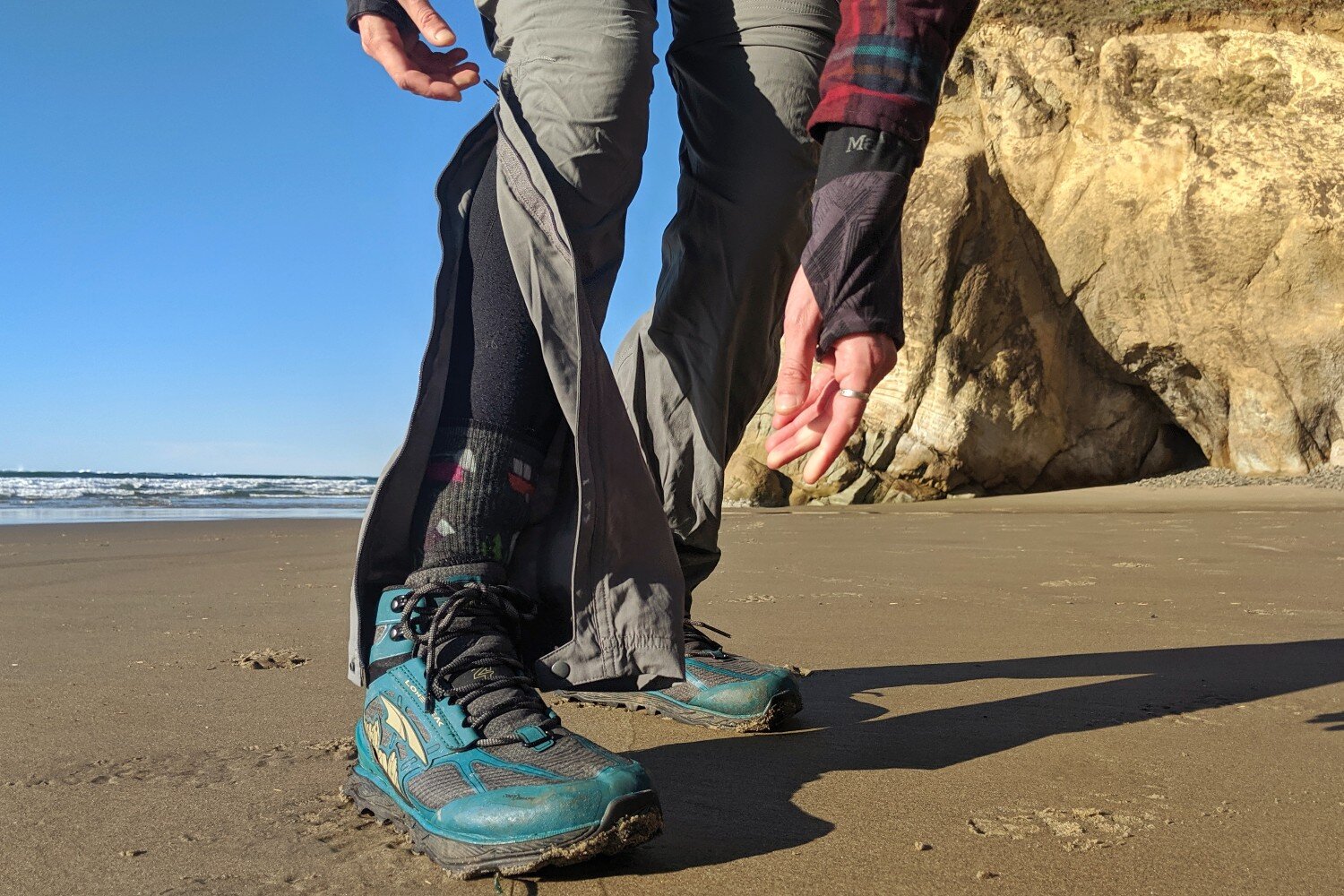
POCKETS
We like the options that pockets provide. Specifically, they make it easier to carry electronics like cell phones or power banks, snacks, sunscreen, maps, headlamps, or other small items with or without a backpack. Because we focus on functional hiking and backpacking attire, we select pants with pockets that keep your things secure.
Back
In our experience, back pockets tend to be the least convenient to use in the backcountry. Unlike hip and leg pockets, it is difficult to reach these pockets while wearing a backpack, making their usability limited.
Hip
Hip-level pockets are generally the most helpful on the trail but can also be the biggest hindrance if they are not designed function-first. Hip pockets are easy to access while wearing a backpack. However, they are also located in an area with a lot of dynamic movement. That means if the pocket does not have the correct shape, some objects may get in the way of leg movement. Another issue is that items may easily fall out if the pocket is too small.
Leg
The comfort and usability of leg pockets primarily depends on the pocket size and how the pants fit. When pants have a very relaxed fit, heavier objects such as cell phones swing around more due to being further from the leg. This can feel uncomfortable over the course of many miles on the trail.
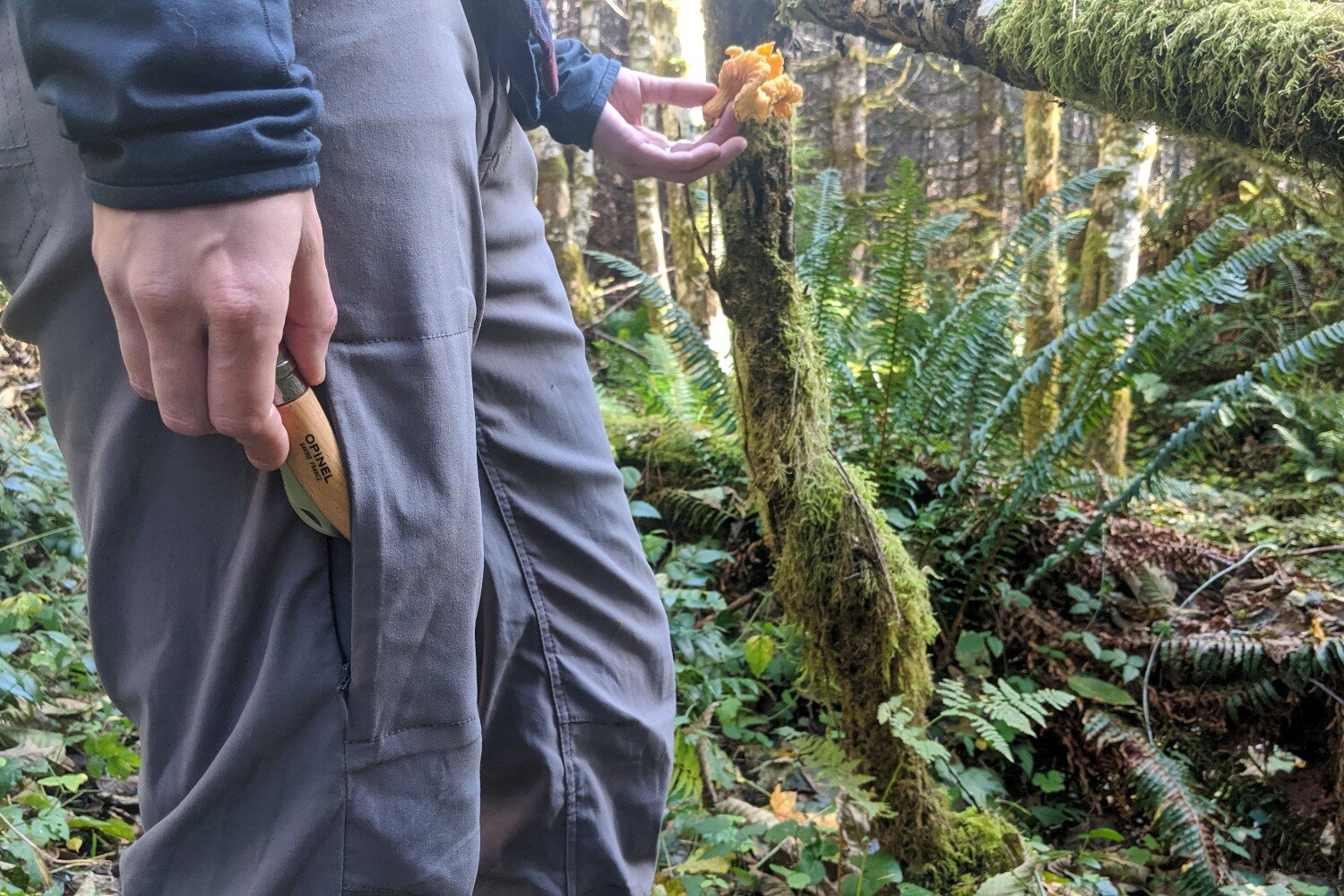
GENERAL CARE
We always recommend reading the care instructions on the label, but here are some strategies for extending the life of a pair of pants.
Use a front-loading washer
Front-loading washers have less hardware and machinery for clothing to catch on. This means that there is less chance of zippers or drawstrings getting damaged in the wash. To reduce the likelihood of damage, we recommend closing zippers and tying waistbands before washing.
Use a technical fabric wash
Outdoor clothing soaps like the Nikwax Tech Wash help extend the lifespan of technical pieces of gear.
Only wash when you really need to
Overwashing wears out even everyday clothing items. Fortunately, most technical clothing has antimicrobial properties that keep them from smelling and should not need to be washed as frequently.
Don’t use fabric softener or dryer sheets
Fabric softeners and dryer sheets can leave remnants on the fabric, which impacts how the pants perform.
Hang dry when possible
The extra heat and pounding from the drying process can increase how quickly a pair of pants wears out.

Conclusion
Finding the ideal pair can be overwhelming with so many hiking pants types and styles. Fortunately, we have spent weeks field-testing and strutting our stuff in the best of the best to assess how well these pants perform. We hope this article will provide the clear and concise information needed to make an informed buying choice.







